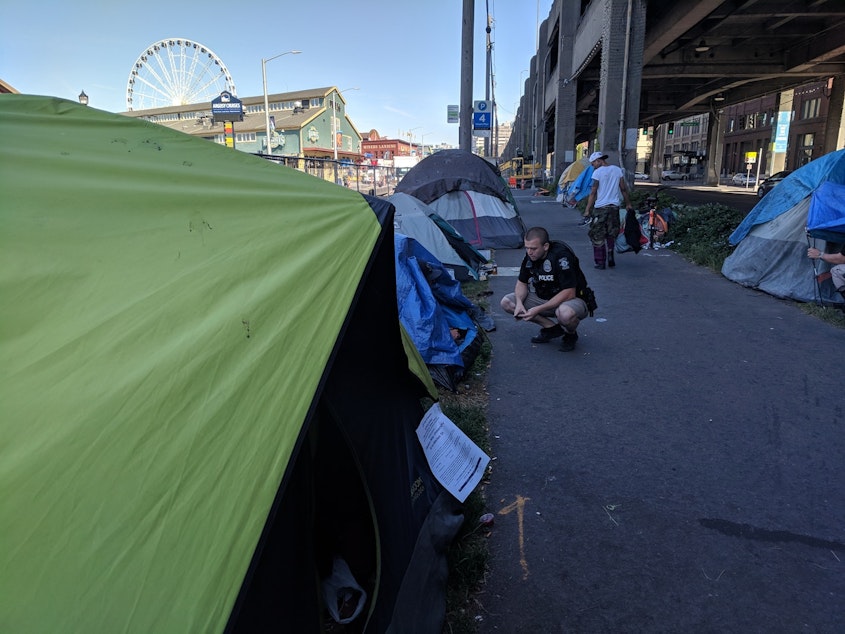Homeless outreach numbers are in for Seattle, and here's what they tell us

The vast majority of homeless people who receive shelter referrals from Seattle’s Navigation Team aren’t showing up at those shelters.
That’s according to newly released data from the city of Seattle.
The Navigation Team is part of the city’s front line response to visible homelessness.
It does outreach to and removal of unauthorized encampments.
In the first three months of this year, the team contacted 731 individuals, according to data reported to the City Council. Of those, 203 individuals accepted offers of shelter and were referred to a shelter.
The city’s data shows 53 of them definitely went to the shelter within 48 hours after the team referred them.
That means just over a quarter of people who accepted shelter ended up going inside.
Sponsored
And overall, that means about 7 percent of the people contacted by the team went into shelter.
During the April-June period, those numbers went up slightly.
City officials say there are caveats on the new numbers. They say there’s a difference between a “contact” by the team and a “shelter referral.”
They say a contact could be short and informal, whereas referrals are the result of relationship building.
They warn that makes those 7 percent and 9 percent figures in the table below misleading.
Sponsored
Shelter referrals from Seattle's Navigation Team
“We don’t draw the relationship back to total contacts, because so many folks are not at a space and not in a place where they are ready to accept a referral, let alone enrollment into shelter,” said Tess Colby, senior adviser on homelessness in Mayor Jenny Durkan’s office.
Also, if someone doesn’t allow their information to be shared among databases, they won’t show up in the tallies. They also might not be counted if they go to a different shelter than the one they were referred to, or use a different name.
Sponsored
Colby said the office is pleased with the increase in the outcomes they’re seeing in the first half of this year.
“What we’re seeing is more folks going into shelter. And that’s exactly what we want to be seeing,” Colby said.
But the officials said they want to see continued improvement. Durkan is seeking $8.4 million for the team in her 2020 budget.
City Councilmember Lisa Herbold said she’s been asking to see this new data for months.
She said other outreach providers contracted by the city are required to refer 60 percent of the people they contact to shelters.
Sponsored
Herbold added a proviso to the budget last year, tying some funding for the team to quarterly reports. She said she’ll push for continued improvement.
The Navigation Team’s work has been controversial in Seattle. It has expanded this year and shifted focus to clearing more small encampments.
In the first six months of 2019, the team cleared more than 200 unauthorized encampments around the city.
The vast majority were smaller camps considered “obstructions” or “hazards.” Unlike larger camps, the rules don’t require a 72-hour notice period for those removals.
A provider called REACH used to work closely with the Navigation Team. But after the switch in focus, REACH has distanced itself, working less with the team and focusing more on outreach in neighborhoods.
Sponsored
REACH director Chloe Gale said focusing on neighborhoods allows their outreach workers to build relationships with people for referrals.
“We take the time to make sure it’s a good fit, that they really want to go and don't just feel pressure to go, confirm they are eligible, and provide concrete assistance like transportation and help with IDs,” Gale said in an email.
Data provided by the mayor’s office show the Navigation Team made more referrals in the first half of 2019 than all other city-funded outreach providers combined.
However, the gap between people being referred to shelter and actually showing up is smaller for other outreach providers when their numbers are combined: Between 54 and 68 percent of people referred to shelter showed up.
There is no national standard for these kinds of outreach metrics, according to staff with the U.S. Interagency Council on Homelessness.
Seattle’s Navigation Team contacts hundreds of people each year. City officials say it’s slow, time-consuming work and they can’t compel people to take shelter.
People may turn down shelter for a range of reasons, including having to split up with partners or pets, or if they can’t take possessions with them.
Jerome Riley has experienced both sides of the team’s work. He told KUOW last year he had turned down offers of shelter and services from the team in the past.
He said mat-on-the-floor shelters weren’t a good fit for him, and he worried about bedbugs, a common concern among people who are living unhoused.
The team has increased the number of attractive shelter options available — with added services — but there still aren't enough spots.
Still, Riley said last year it’s not easy to move every time a camp gets cleared.
“It’s been rough," Riley said. "You’ve got to keep moving back and forth. Keep tearing down and building up, tearing down and building up."
Eventually he accepted an offer of shelter from the team.
Advocates argue that the Navigation Team simply moves people like Riley around the city.
But Erin Goodman, head of the Sodo Business Improvement Area, said the team has a dual role.
“It’s addressing public safety and public health issues. It’s also addressing obstructions that are affecting the entire community,” she said.
The team removed 760 tons of garbage around encampments in the first half of the year.
Goodman said she considers it unrealistic to expect 100 percent of people would take shelter.
“What we see today is much better than what we were seeing before the Navigation Team,” she said.




